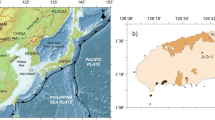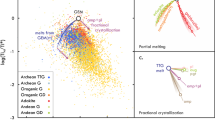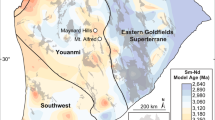Abstract
Foundering of mafic lower continental crust into underlying convecting mantle has been proposed as one means to explain the unusually evolved chemical composition of Earth's continental crust1,2, yet direct evidence of this process has been scarce. Here we report that Late Jurassic high-magnesium andesites, dacites and adakites (siliceous lavas with high strontium and low heavy-rare-earth element and yttrium contents) from the North China craton have chemical and petrographic features consistent with their origin as partial melts of eclogite that subsequently interacted with mantle peridotite. Similar features observed in adakites and some Archaean sodium-rich granitoids of the tonalite-trondhjemite-granodiorite series have been interpreted to result from interaction of slab melts with the mantle wedge. Unlike their arc-related counterparts, however, the Chinese magmas carry inherited Archaean zircons and have neodymium and strontium isotopic compositions overlapping those of eclogite xenoliths derived from the lower crust of the North China craton. Such features cannot be produced by crustal assimilation of slab melts, given the high Mg#, nickel and chromium contents of the lavas. We infer that the Chinese lavas derive from ancient mafic lower crust that foundered into the convecting mantle and subsequently melted and interacted with peridotite. We suggest that lower crustal foundering occurred within the North China craton during the Late Jurassic, and thus provides constraints on the timing of lithosphere removal beneath the North China craton.
This is a preview of subscription content, access via your institution
Access options
Subscribe to this journal
Receive 51 print issues and online access
$199.00 per year
only $3.90 per issue
Buy this article
- Purchase on Springer Link
- Instant access to full article PDF
Prices may be subject to local taxes which are calculated during checkout




Similar content being viewed by others
References
Kay, R. W. & Kay, S. M. Creation and destruction of lower continental crust. Geol. Rundsch. 80, 259–278 (1991)
Rudnick, R. L. Making continental crust. Nature 378, 571–578 (1995)
Rudnick, R. L. & Fountain, D. M. Nature and composition of the continental crust: a lower crustal perspective. Rev. Geophys. 33, 267–309 (1995)
Jull, M. & Kelemen, P. B. On the conditions for lower crustal convective instability. J. Geophys. Res. 106, 6423–6446 (2001)
Kay, R. W. & Kay, S. M. Delamination and delamination magmatism. Tectonophysics 219, 177–189 (1993)
Menzies, A., Fan, W.-M. & Zhang, M. in Magmatic Processes and Plate Tectonics (eds Prichard, H. M., Alabaster, H. M., Harris, T. & Neary, C. R.) 71–81 (Geol. Soc., London, 1993)
Griffin, W. L., Zhang, A. D., O'Reilly, S. Y. & Ryan, C. G. in Mantle Dynamics and Plate Interactions in East Asia (eds Flower, M., Chung, S.-L., Lo, C.-H. & Lee, T.-Y.) 107–126 (American Geophysical Union, Washington DC, 1998)
Gao, S., Rudnick, R. L., Carlson, R. W., McDonough, W. F. & Liu, Y. S. Re-Os evidence for replacement of ancient mantle lithosphere beneath the North China Craton. Earth Planet. Sci. Lett. 198, 307–322 (2002)
Liu, D.-Y., Nutman, A. P., Compston, W., Wu, J. S. & Shen, Q.-H. Remnants of > 3800 Ma crust in the Chinese part of the Sino-Korean craton. Geology 20, 339–342 (1992)
Zheng, J. P. et al. 3.6 Ga lower crust in central China: New evidence on the assembly of the North China Craton. Geology 32, 229–232 (2004)
Zhao, G. C., Wilde, S. A., Cawood, P. A. & Sun, M. Archean blocks and their boundaries in the North China Craton: lithological, geochemical, structural and P-T path constraints and tectonic evolution. Precambr. Res. 107, 45–73 (2001)
Wilde, S. A., Zhou, X. H., Nemchin, A. A. & Sun, M. Mesozoic crust-mantle interaction beneath the North China craton: A consequence of the dispersal of Gondwanaland and accretion of Asia. Geology 31, 817–820 (2003)
Gao, S. et al. How mafic is the lower continental crust? Earth Planet. Sci. Lett. 106, 101–117 (1998)
Huang, Z. X., Su, W., Peng, Y. J., Zheng, Y. J. & Li, H. Y. Rayleigh wave tomography of China and adjacent regions. J. Geophys. Res. 108, doi:10.1029/2001JB001696 (2003)
Kay, R. W. Aleutian magnesian andesites – melts from subducted Pacific ocean crust. J. Volcanol. Geotherm. Res. 4, 117–132 (1978)
Martin, H. Adakitic magmas: modern analogues of Archaean granitoids. Lithos 46, 411–429 (1999)
Watson, E. B. & Harrison, T. M. Zircon saturation revisited: Temperature and composition effects in a variety of crustal magma types. Earth Planet. Sci. Lett. 64, 295–304 (1983)
Wolf, M. B. & Wyllie, P. J. Dehydration-melting of amphibolite at 10 kbar: the effects of temperature and time. Contrib. Mineral. Petrol. 115, 369–383 (1994)
Harrison, T. M. & Watson, E. B. Kinetics of zircon dissolution and zirconium diffusion in granitic melts of variable water content. Contrib. Mineral. Petrol. 84, 66–72 (1983)
Stern, R. A. & Hanson, G. N. Archean high-Mg granodiorite: a derivative of light rare earth element-enriched monzodiorite of mantle origin. J. Petrol. 32, 201–238 (1991)
Atherton, M. P. & Petford, N. Generation of sodium-rich magmas from newly underplated basaltic crust. Nature 362, 144–146 (1993)
Xu, J. F., Shinjo, R., Defant, M. J., Wang, Q. A. & Rapp, R. P. Origin of Mesozoic adakitic intrusive rocks in the Ningzhen area of east China: Partial melting of delaminated lower continental crust? Geology 30, 1111–1114 (2002)
Rapp, R. P., Shimizu, N., Norman, M. D. & Applegate, G. S. Reaction between slab-derived melts and peridotite in the mantle wedge: experimental constraints at 3.8 GPa. Chem. Geol. 160, 335–356 (1999)
Davis, G. A., et al. in Paleozoic and Mesozoic Tectonic Evolution of Central Asia: From Continental Assembly to Intracontinental Deformation (eds Hendrix, M. S. & Davis, G. A.) 171–197 (Memoir Geol. Soc. Am., Boulder, 2001)
Zheng, J. P., Sun, M., Lu, F. X. & Pearson, N. Mesozoic lower crustal xenoliths and their significance in lithospheric evolution beneath the Sino-Korean Craton. Tectonophysics 361, 37–60 (2003)
Xu, W. L., Wang, D. Y., Liu, X. C., Wang, Q. H. & Lin, J. Q. Discovery of eclogite inclusions and its geological significance in early Jurassic intrusive complex in Xuzhou, northern Anhui, eastern China. Chin. Sci. Bull. 47, 1212–1216 (2002)
Ayers, J. C., Dunkle, S., Gao, S. & Miller, C. F. Constraints on timing of peak and retrograde metamorphism in the Dabie Shan Ultrahigh-Pressure Metamorphic Belt, east-central China, using U–Th–Pb dating of zircon and monazite. Chem. Geol. 186, 315–331 (2002)
Qiu, Y. M., Groves, D. I., McNaughton, N. J., Wang, L. G. & Zhou, T. H. Nature, age, and tectonic setting of granitoid-hosted, orogenic gold deposits of the Jiaodong Peninsula, eastern North China craton, China. Mineralium Deposita 37, 283–305 (2002)
Williams, I. S. in Applications of Microanalytical Techniques to Understanding Mineralizing Processes (eds McKibben, M. A., Shanks, W. C. III & Ridley, W. I.) 1–35 (Reviews in Economic Geology, Vol. 7, Society of Economic Geologists, Littleton, Colorado, 1998)
Black, L. P. et al. TEMORA 1: a new zircon standard for Phanerozoic U–Pb geochronology. Chem. Geol. 200, 155–170 (2003)
Ludwig, K. R. ISOPLOT 3.00: A Geochronological Toolkit for Microsoft Excel (Berkeley Geochronology Center, Berkeley, California, 2003)
Yuan, H. L. et al. Accurate U-Pb age and trace element determination of zircon by laser ablation-inductively coupled plasma mass spectrometry. Geostand. Newsl. (in the press)
Rudnick, R. L., Gao, S., Ling, W. L., Liu, Y. S. & McDonough, W. F. Petrology and geochemistry of spinel peridotite xenoliths from Hannuoba and Qixia, North China craton. Lithos 77, 609–637 (2004)
Acknowledgements
This research was supported by the National Natural Science Foundation of China, Chinese Ministry of Science and Technology and the Beijing SHRIMP Center (S.G. and H.L.Y.) and the NSF (R.L.R. and J.C.A). We thank D. Y. Liu, Z. C. Hu, G. M. Shu and Y. B. Wang for help in SHRIMP II and electron microprobe analyses, and D. Günther for help in setting up the LA-ICP-MS. This Letter benefited from comments and suggestions from S. Wilde and H. Rollinson.
Author information
Authors and Affiliations
Corresponding authors
Ethics declarations
Competing interests
The authors declare that they have no competing financial interests.
Supplementary information
Supplementary Figures 1, 2, 3
These three figures show cathodoluminescence (CL) images and ages of the selected zircons analyzed by SHRIMP II for Xinglonggou lavas XL31, XL34 and XL03, respectively. Includes accompanying text. (PDF 2020 kb)
Supplementary Table 1
This table gives zircon U-Pb age data for five Xinglonggou lavas obtained by SHRIMP II and LA-ICP-MS. (XLS 830 kb)
Supplementary Table 2
This table gives LA-ICP-MS elemental analytical data for one large inherited zircon grain from XL18 (Fig. 2b). (XLS 21 kb)
Supplementary Table 3
This table gives LA-ICP-MS elemental analytical data for one large inherited zircon grain from XL18 (Fig. 2b). (XLS 21 kb)
Supplementary Table 4
This table gives average chemical compositions of minerals of Xinglonggou lavas obtained by electron microprobe. (XLS 26 kb)
Supplementary Table 5
This table gives geochemical and isotopic compositions of 31 Xinglonggou lavas. (XLS 58 kb)
Supplementary Table 6
This table gives SHRIMP U-Pb age data for few available zircons from Xu-Huai eclogite (sample 603-2-2) and garnet clinopyroxenite (sample 603-2-1) xenoliths. (XLS 23 kb)
Supplementary Data
This gives data sources for zircon 207Pb/206Pb ages of Archaean and Paleoproterozoic rocks from the North China Craton used for Fig. 2c. (DOC 52 kb)
Supplementary Discussion
This gives a detailed explanation, data sources and modelling parameters of Figure 4. (DOC 46 kb)
Rights and permissions
About this article
Cite this article
Gao, S., Rudnick, R., Yuan, HL. et al. Recycling lower continental crust in the North China craton. Nature 432, 892–897 (2004). https://doi.org/10.1038/nature03162
Received:
Accepted:
Issue Date:
DOI: https://doi.org/10.1038/nature03162
This article is cited by
-
Petrogenesis and tectonic setting of the mafic rocks from the Mfengou-Manki area, Central Cameroon Shear Zone: constraints from petrology and bulk-rock geochemistry
Discover Applied Sciences (2024)
-
Contributions of juvenile lower crust and mantle components to porphyry Cu deposits in an intracontinental setting: evidence from late Mesozoic porphyry Cu deposits in the South Qinling Orogenic Belt, Central China
Mineralium Deposita (2023)
-
Permian–Triassic magmatic rocks in the Middle Gobi volcanic-plutonic belt, Mongolia: revisiting the scissor-like closure model of the Mongol-Okhotsk Ocean
International Journal of Earth Sciences (2023)
-
Receiver function imaging of dense seismic array and deep dynamic mechanism beneath the eastern South China
Science China Earth Sciences (2023)
-
Variability of rare earth and heavy metal elements in a representative alluvial depositional system
Environmental Science and Pollution Research (2023)
Comments
By submitting a comment you agree to abide by our Terms and Community Guidelines. If you find something abusive or that does not comply with our terms or guidelines please flag it as inappropriate.



